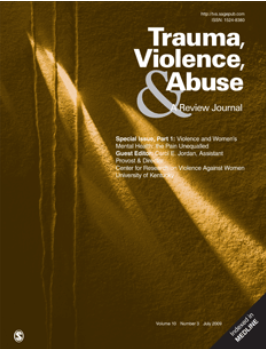Patient Ethnicity and Staff Use of Restraints and Restrictive Practice in Inpatient Psychiatric Services: A Systematic Review
IF 5.4
1区 社会学
Q1 CRIMINOLOGY & PENOLOGY
引用次数: 0
Abstract
Restrictive practices such as restraints, seclusion, and forced medication are only intended to be used when the threat is at a level whereby an individual is likely to inflict harm on themselves or another individual. Demographic variations, including ethnicity, may be associated with the use of these practices. However, there is no systematic review on patient ethnicity specifically. The review therefore aimed to establish whether a patient’s ethnic identity was associated with staff use of restrictive practices in inpatient psychiatric services. The systematic review followed the Preferred Reporting Items for Systematic Review and Meta-Analysis guidelines. Four databases were searched (PsycINFO, Medline, Embase, and CINAHL). Methodological quality was assessed using the Critical Appraisal Skills Program Checklists. Fifteen studies met the inclusion criteria. A variety of ethnicities were identified within the studies. These were driven by the location of the study. Seclusion (14 studies), forced medication (4), and physical restraint (4) were explored. There were mixed findings, with ethnicity shown to predict restrictive practices in studies having larger participant numbers, longer follow-up periods and less methodological bias. It remains unclear whether ethnicity is a genuinely independent predictor of restraint and coercive practices or interacts with other risk factors. Staff working in inpatient settings should be aware of how unconscious biases might affect clinical practice. Recruiting a diverse workforce from minority ethnic groups into inpatient psychiatric services would be a positive step. However, support for these staff members is important, and all staff should be equipped to respond to ethnic diversity. Future research should explore beyond patient-level factors.住院精神病服务中患者种族和工作人员使用约束和限制性实践:系统回顾
限制性做法,如约束、隔离和强制用药,只有在威胁达到个人可能对自己或他人造成伤害的程度时才会使用。包括种族在内的人口差异可能与这些做法的使用有关。然而,没有专门针对患者种族的系统评价。因此,该审查旨在确定患者的种族身份是否与住院精神病服务中工作人员使用限制性做法有关。系统评价遵循系统评价和荟萃分析指南的首选报告项目。检索了四个数据库(PsycINFO、Medline、Embase和CINAHL)。使用关键评估技能项目清单评估方法学质量。15项研究符合纳入标准。在研究中发现了各种各样的种族。这些都是由研究地点决定的。对隔离(14例)、强制用药(4例)和身体约束(4例)进行了探讨。研究结果好坏参半,在参与者人数较多、随访时间较长、方法偏差较小的研究中,种族可以预测限制性实践。目前尚不清楚种族是否是约束和强制行为的真正独立预测因素,还是与其他风险因素相互作用。在住院部工作的工作人员应该意识到无意识的偏见是如何影响临床实践的。从少数民族群体中招募多样化的劳动力进入住院精神病服务将是一个积极的步骤。但是,对这些工作人员的支持是重要的,所有工作人员都应具备对种族多样性作出反应的能力。未来的研究应探索患者层面以外的因素。
本文章由计算机程序翻译,如有差异,请以英文原文为准。
求助全文
约1分钟内获得全文
求助全文
来源期刊

Trauma Violence & Abuse
Multiple-
CiteScore
13.60
自引率
7.80%
发文量
131
期刊介绍:
Trauma, Violence, & Abuse is devoted to organizing, synthesizing, and expanding knowledge on all force of trauma, abuse, and violence. This peer-reviewed journal is practitioner oriented and will publish only reviews of research, conceptual or theoretical articles, and law review articles. Trauma, Violence, & Abuse is dedicated to professionals and advanced students in clinical training who work with any form of trauma, abuse, and violence. It is intended to compile knowledge that clearly affects practice, policy, and research.
 求助内容:
求助内容: 应助结果提醒方式:
应助结果提醒方式:


